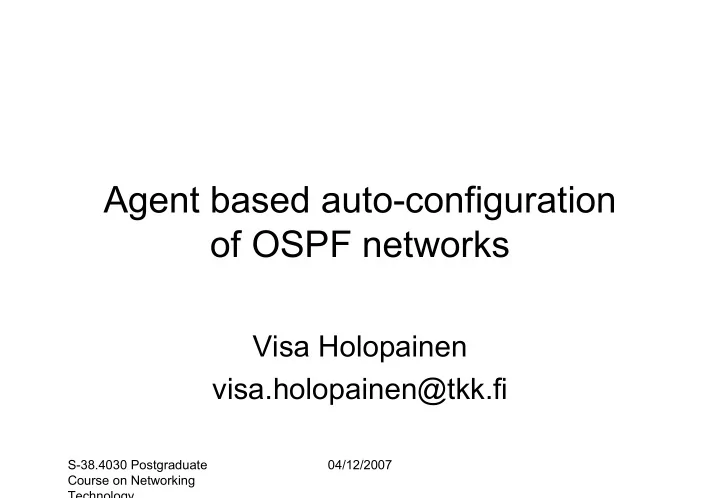

Agent based auto-configuration of OSPF networks Visa Holopainen visa.holopainen@tkk.fi S-38.4030 Postgraduate 04/12/2007 Course on Networking Technology
Problem • About 30% - 50% of network outages are caused by configuration error (The Yankee Group's 2003 query) • It would be nice to automate manual error- prone configuration tasks S-38.4030 Postgraduate 04/12/2007 Course on Networking Technology
Previous work in auto-configuration Many high-level Many working proposals systems LAN : WAN : LAN : WAN : workstations/ routers workstations/ routers modems/swit modems/swit ches ches S-38.4030 Postgraduate 04/12/2007 Course on Networking Technology
Our work A working system WAN : WAN : routers routers S-38.4030 Postgraduate 04/12/2007 Course on Networking Technology
What is it? • The main idea in our system is following: – A person with very limited or no computer skills can take several commodity PCs, connect their Network Interface Cards (NICs), plug a specifically configured laptop to one of those PCs, and after a while the network will be a fully functional OSPF network. S-38.4030 Postgraduate 04/12/2007 Course on Networking Technology
Problem • At first there’s no connectivity to routers (unless a separate management LAN is set up) • How about auto-configuration using CD/USB? – possible but may be logistically complicated if routers are in different physical locations S-38.4030 Postgraduate 04/12/2007 Course on Networking Technology
Our solution • ”Flood” routing protocol to the network -> incrementally increase connectivity range until all routers have been configured S-38.4030 Postgraduate 04/12/2007 Course on Networking Technology
auto-configuration process (1) Autoconfig package contains: 1. agent Perl-script 2. routing software tarball 3. a file that contains IP addresses of interfaces that have already been configured to run OSPF (the master script maintains this file) 4. a policy file S-38.4030 Postgraduate 04/12/2007 Course on Networking Technology
auto-configuration process (2) S-38.4030 Postgraduate 04/12/2007 Course on Networking Technology
Policy file • Plain and simple • Suitable default values in most parts • networking novice should be able to fill in suitable values where needed S-38.4030 Postgraduate 04/12/2007 Course on Networking Technology
Master • Main purpose of master is to send agents to PCs one at a time and maintain configured and candidate IPs S-38.4030 Postgraduate 04/12/2007 Course on Networking Technology
Agent • Agent: – Discovery of neighbor PCs – Preparation of neighbor PCs – Decompression, installation, configuration, and starting of routing software – Informing the master about own (configured) and neighboring IPs S-38.4030 Postgraduate 04/12/2007 Course on Networking Technology
Auto-configuration basic stuff • Each ethernet-interface that the agent detects (using ifconfig-tool) will cause the agent to write the following line to configuration file: network X.Y.Z.V/N area 0 . Here X.Y.Z.V/N is the IP network configured for the interface S-38.4030 Postgraduate 04/12/2007 Course on Networking Technology
Policy -> Configuration • The agent writes configuration commands based on the policy file that the master sent – if (policy_entry X ) then write_configuration Y • Example 1: If the agent notices that one of the interfaces on the PC it is running on has the IP address of default gateway specified in policy file, then the agent writes the following to configuration file: default-information originate . S-38.4030 Postgraduate 04/12/2007 Course on Networking Technology
Policy -> Configuration examples S-38.4030 Postgraduate 04/12/2007 Course on Networking Technology
Features • Currently in addition to the basic routing functionality: – Stubnets : if there is no reply from an interface it is configured to be passive – Broadcast networks = switches/hubs are allowed – Default Internet gateway (not tested) – ECMP load balancing (not tested) – <your suggestion> – other protocols like BGP (maybe in the future) S-38.4030 Postgraduate 04/12/2007 Course on Networking Technology
Performance (1) Test started 0 sec Sent agent to A 291 sec A done 1799 sec Sent agent to B 1978 sec B done 2969 sec Sent agent to C 3147 sec C done 3788 sec Sent agent to D 3967 sec D done 4298 sec S-38.4030 Postgraduate 04/12/2007 Course on Networking Technology
Performance (2) Test started 0 sec Sent agent to A 292 sec A done 2401 sec Sent agent to B 2579 sec B done 3844 sec Sent agent to C 4022 sec C done 4663 sec Sent agent to D 4842 sec D done 5172 sec S-38.4030 Postgraduate 04/12/2007 Course on Networking Technology
2500 2000 Execution time of agent (seconds) 1500 Test 1 Test 2 1000 500 0 agent A agent B agent C agent D S-38.4030 Postgraduate 04/12/2007 Course on Networking Technology
Conclusions • With Perl it is easy to build a working auto- configuration system for Linux network (however, debugging takes longer) • Net::SSH::Expect is awfully slow – However, if you don’t know how to configure routers, an hour is a short time… – Also, using SSH instead of Telnet makes it possible to configure the network from a separate physical location S-38.4030 Postgraduate 04/12/2007 Course on Networking Technology
Future work: IP auto-assignment Issue 1: How to get the PCs to send DHCP-discoveries at startup – need to use a script that does this? Issue 2: A hack needed to run DHCP on multiple interfaces S-38.4030 Postgraduate 04/12/2007 Course on Networking Technology
Future work: OS auto-installation S-38.4030 Postgraduate 04/12/2007 Course on Networking Technology
Recommend
More recommend